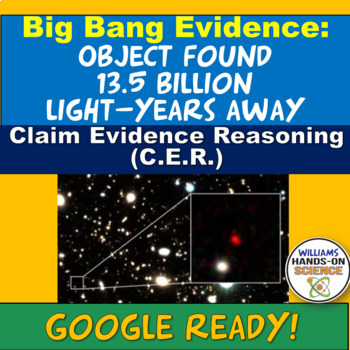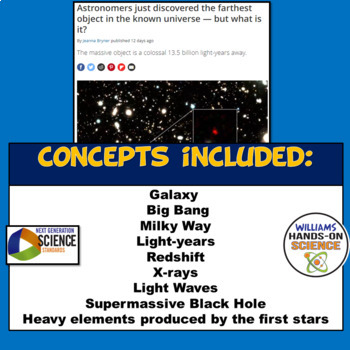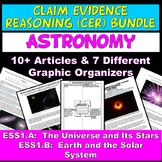Big Bang Theory Oldest Object In Universe Found NGSS Claim Evidence Reasoning
- Zip
- Google Apps™

Also included in
- Students learn about various current events and discoveries in Astronomy through a C.E.R. (Claim Evidence Reasoning) graphic organizer. This is great for getting your students to explain phenomena in a meaningful way and it allows you as the instructor to adequately assess their understanding of conPrice $34.00Original Price $66.50Save $32.50
Description
Students learn how an object was found 13.5 billion light years away, making it the oldest object in the universe ever found through a C.E.R. (Claim Evidence Reasoning) graphic organizer. This is great for getting your students to explain phenomena in a meaningful way and it allows you as the instructor to adequately assess their understanding of concepts. The students figure out what the "Claim" is in the article, they then use data that supports the claim in the "Evidence" section, draw visual evidence and then explain why the evidence supports the claim in the "Reasoning" section.
The article has the following concepts:
Galaxy
Big Bang
Milky Way
Light-years
Redshift
X-rays
Light Waves
Supermassive Black Hole
Heavy elements produced by the first stars
Take a look at my CER Mega bundle!
This is great for a current event, sub plan, homework, critical thinking, scaffolding and/or reinforcement of concepts!
You get a CER graphic organizer, an editable key, the article, tips for CER and the link to the website in the article.
NGSS Standards:
DCI's:
PS4.B: Electromagnetic Radiation
Atoms of each element emit and absorb characteristic frequencies of light. These characteristics allow identification of the presence of an element, even in microscopic quantities. (secondary to HS-ESS1-2)
ESS1.A: The Universe and Its Stars
The study of stars’ light spectra and brightness is used to identify compositional elements of stars, their movements, and their distances from Earth. (HS-ESS1-2), (HS-ESS1-3)
The Big Bang theory is supported by observations of distant galaxies receding from our own, of the measured composition of stars and non-stellar gases, and of the maps of spectra of the primordial radiation (cosmic microwave background) that still fills the universe. (HS-ESS1-2)
Other than the hydrogen and helium formed at the time of the Big Bang, nuclear fusion within stars produces all atomic nuclei lighter than and including iron, and the process releases electromagnetic energy. Heavier elements are produced when certain massive stars achieve a supernova stage and explode. (HS-ESS1-2), (HS-ESS1-3
ESS1.A: The Universe and Its Stars
Earth and its solar system are part of the Milky Way galaxy, which is one of many galaxies in the universe. (MS-ESS1-2)
PS4.B: Electromagnetic Radiation
Electromagnetic radiation (e.g., radio, microwaves, light) can be modeled as a wave of changing electric and magnetic fields or as particles called photons. The wave model is useful for explaining many features of electromagnetic radiation, and the particle model explains other features. (HS-PS4-3)
SEP's
Asking Questions and Defining Problem:
Students at any grade level should be able to ask questions of each other about the texts they read, the features of the phenomena they observe, and the conclusions they draw from their models or scientific investigations.
Engaging in Argument from Evidence:
In 9–12 builds on K–8 experiences and progresses to using appropriate and sufficient evidence and scientific reasoning to defend and critique claims and explanations about the natural and designed world(s). Arguments may also come from current scientific or historical episodes in science.
Construct an explanation based on valid and reliable evidence obtained from a variety of sources (including students' own investigations, models, theories, simulations, peer review) and the assumption that theories and laws that describe the natural world operate today as they did in the past and will continue to do so in the future. (HS-ESS1-2)
CCC's
CCC1: Patterns
CCC1: Patterns
Observed patterns of forms and events guide organization and classification, and they prompt questions about relationships and the factors that influence them.
Systems and System Models
Models (e.g., physical, mathematical, computer models) can be used to simulate systems and interactions—including energy, matter, and information flows—within and between systems at different scales. (HS-LS2-5)
Energy and Matter
Changes of energy and matter in a system can be described in terms of energy and matter flows into, out of, and within that system. (HS-LS1-5), (HS-LS1-6)
Energy cannot be created or destroyed—it only moves between one place and another place, between objects and/or fields, or between systems. (HS-LS1-7), (HS-LS2-4)
Energy drives the cycling of matter within and between systems. (HS-LS2-3)
TERMS OF USE
• All rights reserved by Williams Hands On Science, Inc.
• This product is to be used by the original purchaser only.
• Intended for classroom and personal use only.
• Copying for more than one teacher, classroom, department, school, or school system is prohibited.
• This product may not be distributed or displayed digitally for public view.
• Failure to comply is a copyright infringement and a violation of the Digital Millennium Copyright Act (DMCA).
If there are any errors or questions, please contact me through TpT or email me at:
williamshandsonscience@gmail.com
Thank you for taking a look!
Please follow me on TpT for new products and check me out on Instagram for my products in action!
https://www.instagram.com/williams_hands_on_science/
Related Products
⭐ Claim Evidence Reasoning (CER): Autumn Equinox Can Fall on Different Days
⭐ Claim Evidence Reasoning Growing Bundle
⭐ NGSS Black Holes & Galaxies Claim Evidence Reasoning Graphic Organizer
⭐ NGSS Claim Evidence Reasoning (CER) Big Bang Graphic Organizer
⭐ NGSS Claim Evidence Reasoning (CER) High Frequency Sound Waves
⭐ NGSS Claim Evidence Reasoning The Mysterious Planet Nine Solar System Astronomy
⭐ NGSS Claim Evidence Reasoning (CER) Water Found on Mars
⭐ ⭐ NGSS Common Core Claim Evidence Reasoning (CER) Graphic Organizers
⭐ NGSS Expanding Universe Claim Evidence Reasoning Graphic Organizer






